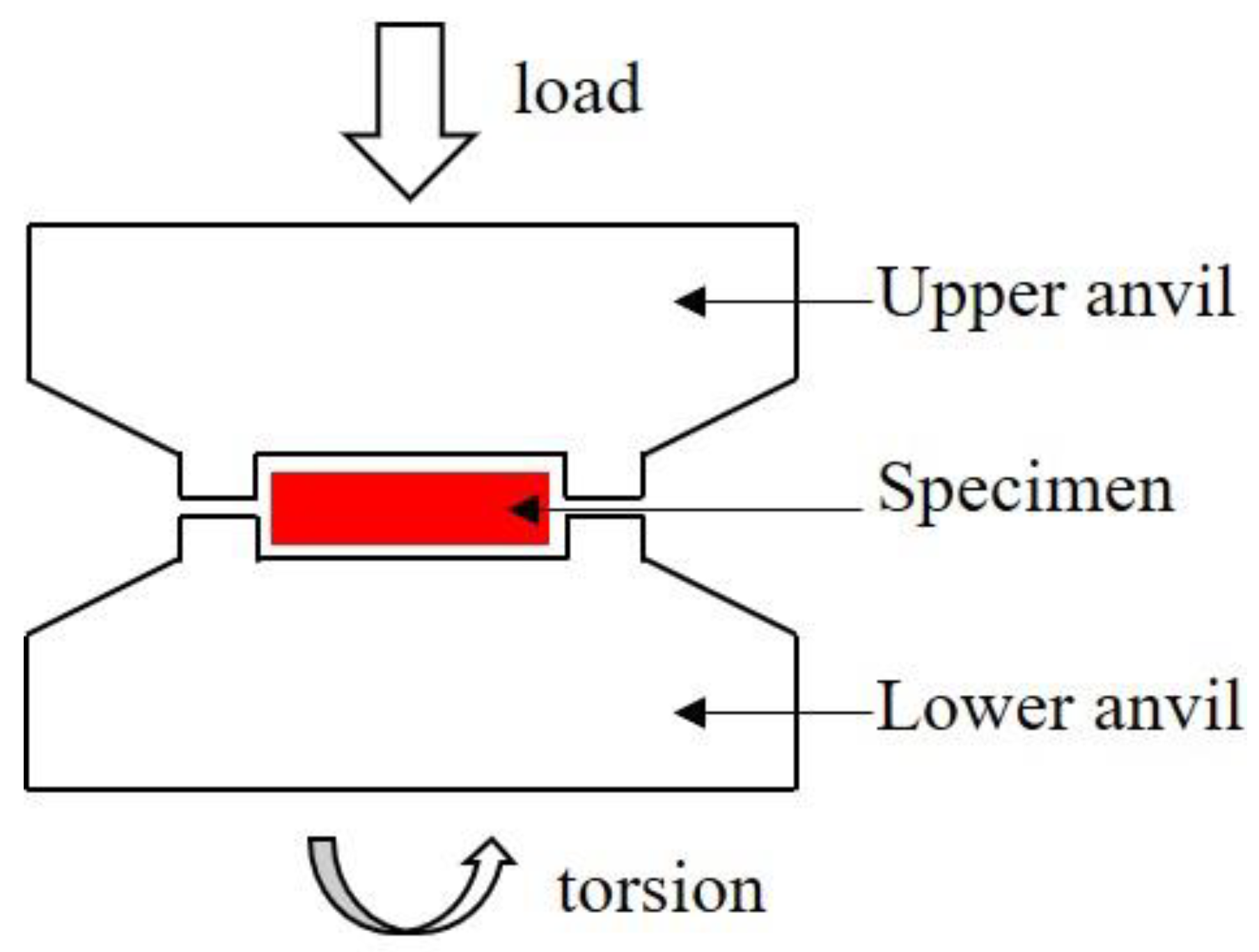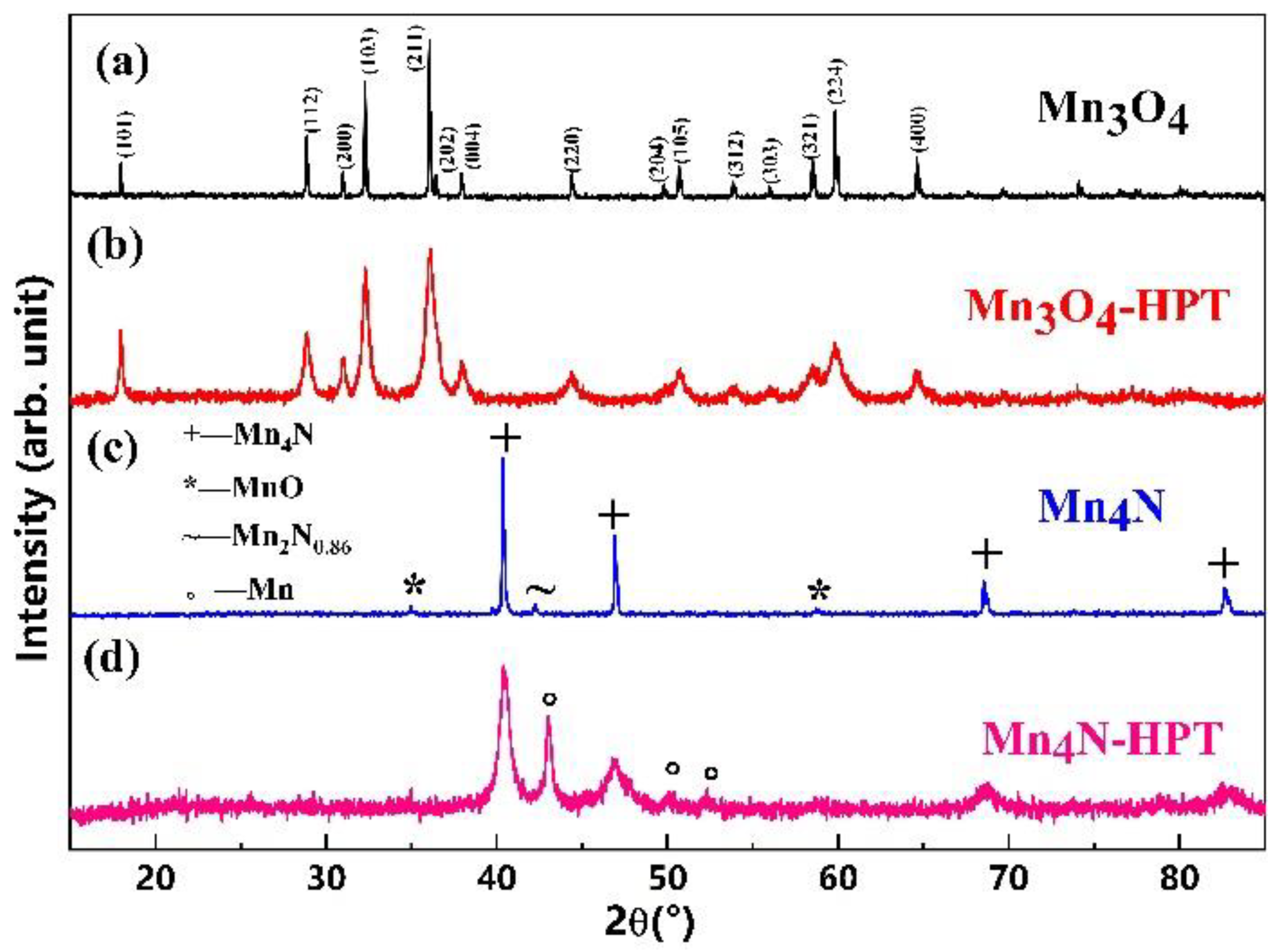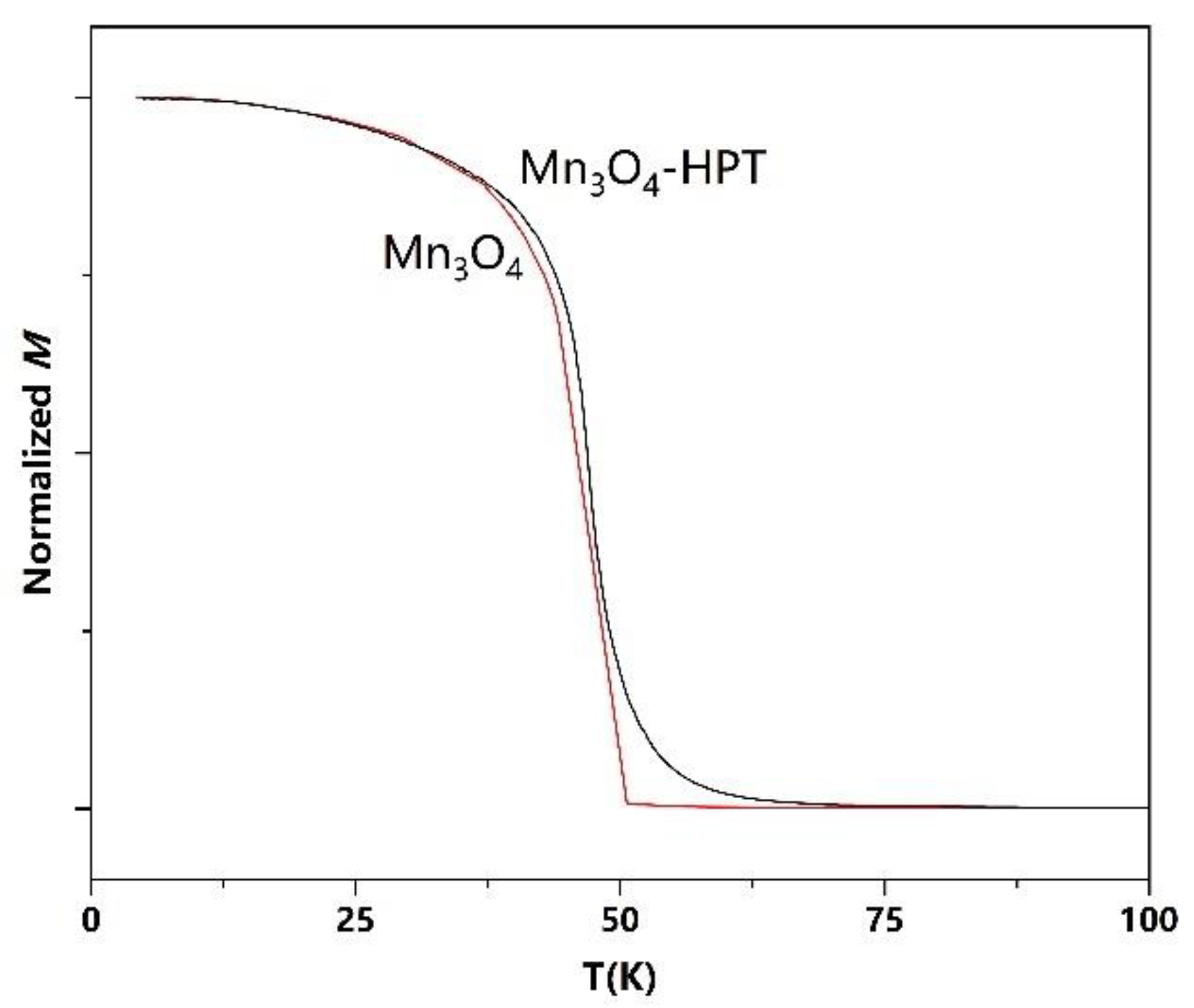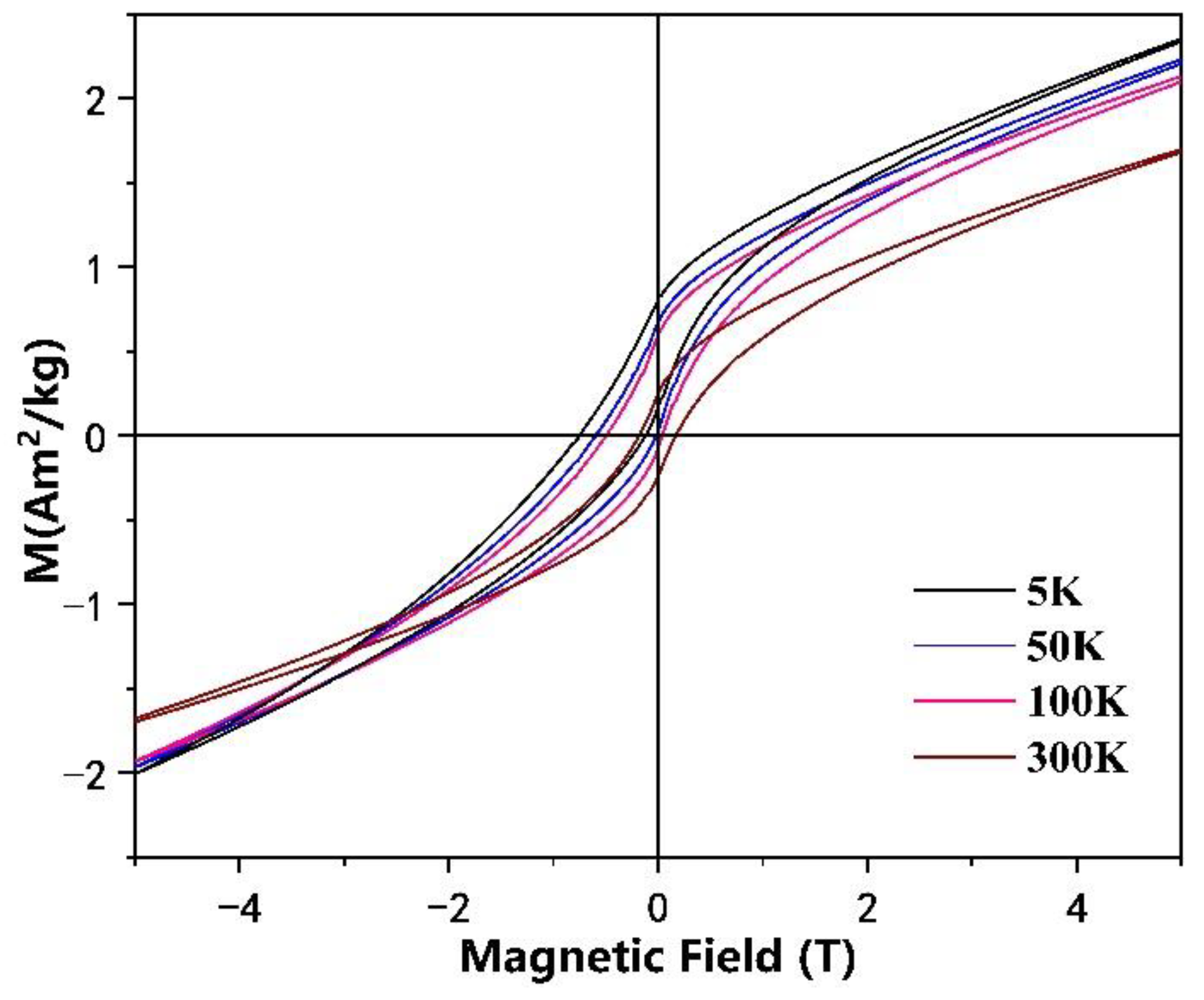A Review of Ultrafine-Grained Magnetic Materials Prepared by Using High-Pressure Torsion Method
Abstract
1. Introduction
2. Principles of High-Pressure Torsion
2.1. Historical Background of HPT
2.2. Devices and Parameters of High-Pressure Torsion
3. Application of HPT to Pure Magnetic Elements
4. Application of HPT to Binary Magnetic Alloys
4.1. Fe-Based Binary Alloys
4.2. Co-Based Binary Alloys
4.3. Ni-Based Binary Alloys
4.4. Mn-Based Binary Alloys
5. Application of HPT to Ternary Magnetic Alloys and Intermetallic Compounds
6. Application of HPT to Magnetic Oxides
7. Application of HPT to Magnetic Nitrides
8. Application of HPT to Magnetic Composites
9. Challenges and Future Prospects for Applications of HPT in Magnetic Materials
Author Contributions
Funding
Institutional Review Board Statement
Informed Consent Statement
Data Availability Statement
Conflicts of Interest
References
- Bridgman, P.W. Effects of High Shearing Stress Combined with High Hydrostatic Pressure. Phys. Rev. 1935, 48, 825–847. [Google Scholar] [CrossRef]
- Edalati, K.; Horita, Z. A review on High-Pressure Torsion (HPT) from 1935 to 1988. Mater. Sci. Eng. A 2016, 652, 325–352. [Google Scholar] [CrossRef]
- Zhilyaev, A.; Langdon, T. Using High-Pressure Torsion for Metal Processing: Fundamentals and applications. Prog. Mater. Sci. 2008, 53, 893–979. [Google Scholar] [CrossRef]
- Song, Y.; Wang, W.; Lee, D.J.; Jeong, H.J.; Lee, S.; Kim, H.S. Thickness inhomogeneity in Hardness and Microstructure of Copper after the Compressive Stage in High-Pressure Torsion. Met. Mater. Int. 2015, 21, 7–13. [Google Scholar] [CrossRef]
- Oba, Y.; Adachi, N.; Todaka, Y.; Gilbert, E.P.; Mamiya, H. Anomalous Magnetic Anisotropy and Magnetic Nanostructure in Pure Fe induced by High-Pressure Torsion Straining. Phys. Rev. Res. 2020, 2, 033473. [Google Scholar] [CrossRef]
- Herzer, G. Grain Size Dependence of Coercivity and Permeability in Nanocrystalline Ferromagnets. IEEE Trans. Magn. 2002, 26, 1397–1402. [Google Scholar] [CrossRef]
- Hosokawa, A.; Ohtsuka, H.; Li, T.; Ii, S.; Tsuchiya, K. Micostructure and Magnetic Properties in Nanostructured Fe and Fe-Based Intermetallics Produced by High-Pressure Torsion. Mater. Trans. 2014, 55, 1286–1291. [Google Scholar] [CrossRef]
- Hossain, M.K.; Ferdous, J.; Haque, M.M.; Hakim, A.K.M.A. Study and Characterization of Soft Magnetic Properties of Fe73.5Cu1Nb3Si13.5B9 Magnetic Ribbon Prepared by Rapid Quenching Method. Mater. Sci. Appl. 2015, 6, 1089–1099. [Google Scholar] [CrossRef]
- Hossain, M.K.; Ferdous, J.; Haque, M.M.; Hakim, A.K.M.A. Development of Nanostructure Formation of Fe73.5Cu1Nb3Si13.5B9 Alloy from Amorphous State on Heat Treatment. World J. Nano Sci. Eng. 2015, 5, 107–114. [Google Scholar] [CrossRef][Green Version]
- Hoque, M.A.; Ahmed, M.R.; Rahman, G.T.; Rahman, M.T.; Islam, M.A.; Khan, M.A.; Hossain, M.K. Fabrication and Comparative Study of Magnetic Fe and α-Fe2O3 Nanoparticles Dispersed Hybrid Polymer (PVA + Chitosan) Novel Nanocomposite Film. Results Phys. 2018, 10, 434–443. [Google Scholar] [CrossRef]
- Weissitsch, L.; Wurster, S.; Paulischin, A.; Stückler, M.; Pippan, R.; Bachmaier, A. Nanocrystalline FeCr alloys Synthesised by Severe Plastic Deformation—A Potential Material for Exchange Bias and Enhanced Magnetostriction. J. Magn. Magn. Mater. 2021, 534, 168017. [Google Scholar] [CrossRef]
- Singh, S.P.; Witte, R.; Clemens, O.; Sarkar, A.; Velasco, L.; Kruk, R.; Hahn, H. Magnetic Tb75Fe25 Nanoglass for Cryogenic Permanent Magnet Undulator. ACS Appl. Nano Mater. 2020, 3, 7281–7290. [Google Scholar] [CrossRef]
- Glezer, A.M.; Louzguine-Luzgin, D.V.; Muradimova, L.F.; Shirshikov, S.O.; Libman, M.A.; Shchetinin, I.V.; Perov, N.S.; Dyakonov, D.L.; Sundeev, R.V. Observation of γ-phase Suppression Effect in Soft-Magnetic FeCo-(3–6) %V Alloys under High Pressure Torsion. Intermetallics 2019, 115, 106615. [Google Scholar] [CrossRef]
- Bridgman, P.W. On Torsion Combined with Compression. J. Appl. Phys. 1943, 14, 273–283. [Google Scholar] [CrossRef]
- Valiev, R.Z.; Kuznetsov, O.; Musalimov, R.S.; Tsenev, N.K. Low-temperature Superplasticity of Metallic Materials. Sov. Phys. Dokl. 1988, 33, 626. [Google Scholar]
- Valiev, R.Z.; Krasilnikov, N.A.; Tsenev, N.K. Plastic Deformation of Alloys with Submicron-grained Structure. Mater. Sci. Eng. A 1991, 137, 35–40. [Google Scholar] [CrossRef]
- Griggs, D.T.; Turner, E.J.; Heard, H.C. Deformation of Rocks at 500–800 °C. Geol. Soc. Am. 1960, 79, 39–104. [Google Scholar] [CrossRef]
- Riecker, R.E. New Shear Apparatus for Temperatures of 1000 °C and Pressures of 50 Kilobars. Rev. Sci. Instrum. 1964, 35, 596–599. [Google Scholar] [CrossRef]
- Valiev, R.Z.; Mulyukov, R.R.; Ovchinnikov, V.V. Direction of a Grain-Boundary Phase in Submicrometre-Grained Iron. Philos. Mag. Lett. 1990, 62, 253–256. [Google Scholar] [CrossRef]
- Scheriau, S.; Kriegisch, M.; Kleber, S.; Mehboob, N.; Grössinger, R.; Pippan, R. Magnetic Characteristics of HPT Deformed Soft-Magnetic Materials. J. Magn. Magn. Mater. 2010, 322, 2984–2988. [Google Scholar] [CrossRef]
- Protasova, S.G.; Straumal, B.B.; Dobatkin, S.V.; Goll, D.; Schütz, G.; Baretzky, B.; Mazilkin, A.A.; Nekrasov, A.N. Coercivity and Domain Structure of Nanograined Fe–C alloys after High-Pressure Torsion. J. Mater. Sci. 2008, 43, 3775–3781. [Google Scholar] [CrossRef][Green Version]
- Stückler, M.; Weissitsch, L.; Wurster, S.; Felfer, P.; Krenn, H.; Pippan, R.; Bachmaier, A. Magnetic Dilution by Severe Plastic Deformation. AIP Adv. 2020, 10, 0152101. [Google Scholar] [CrossRef]
- Nishihata, S.; Suehiro, K.; Arita, M.; Masuda, M.; Horita, Z. High-Pressure Torsion for Giant Magnetoresistance and Better Magnetic Properties. Adv. Eng. Mater. 2010, 12, 793–797. [Google Scholar] [CrossRef]
- Si, P.Z.; Lim, J.T.; Park, J.; Lee, H.H.; Ge, H.; Lee, H.; Han, S.; Kim, H.S.; Choi, C.J. High Coercivity in MnAl Disc Prepared by Severe Plastic Deformation. Phys. Status Solidi 2020, 257, 1900356. [Google Scholar] [CrossRef]
- Straumal, B.B.; Protasova, S.G.; Mazilkin, A.A.; Kogtenkova, O.A.; Kurmanaeva, L.; Baretzky, B.; Schütz, G.; Korneva, A.; Zięba, P. SPD-induced Changes of Structure and Magnetic Properties in the Cu–Co Alloys. Mater. Lett. 2013, 98, 217–221. [Google Scholar] [CrossRef]
- Straumal, B.B.; Protasova, S.G.; Mazilkin, A.A.; Baretzky, B.; Goll, D.; Gunderov, D.V.; Valiev, R.Z. Effect of Severe Plastic Deformation on the Coercivity of Co–Cu alloys. Philos. Mag. Lett. 2009, 89, 649–654. [Google Scholar] [CrossRef]
- Mulyokov, K.Y.; Korznikova, G.F.; Abdulov, R.Z.; Valiev, R.Z. Magnetic Hysteretic Properties of Submicron Grained Nickel and their Variations upon Annealing. J. Magn. Magn. Mater. 1990, 89, 207–213. [Google Scholar] [CrossRef]
- Edalati, K.; Toh, S.; Arita, M.; Watanabe, M.; Horita, Z. High-Pressure Torsion of Pure Cobalt: Hcp-fcc phase Transformations and Twinning During Severe Plastic Deformation. Appl. Phys. Lett. 2013, 102, 181902. [Google Scholar] [CrossRef]
- Mulyukov, K.Y.; Korznikova, G.F.; Sagdatkireyeva, M.B.; Timofeyev, V.N.; Valiev, R.Z. The Study of Domain Structure of Submicron Grained Cobalt and its Changes During Heating. J. Magn. Magn. Mater. 1992, 110, 73–79. [Google Scholar] [CrossRef]
- Popov, V.V.; Popova, E.N.; Kuznetsov, D.D.; Stolbovskii, A.V.; Pilyugin, V.P. Thermal Stability of Nickel Structure Obtained by High-Pressure Torsion in Liquid Nitrogen. Phys. Met. Metallogr. 2014, 115, 682–691. [Google Scholar] [CrossRef]
- Oba, Y.; Bersweiler, M.; Titov, I.; Adachi, N.; Michels, A. Role of Higher-Order Effects in Spin-Misalignment Small-Angle Neutron Scattering of High-Pressure Torsion Nickel. Phys. Rev. Mater. 2021, 5, 084410. [Google Scholar] [CrossRef]
- Mulyukov, K.Y.; Korznikova, G.F.; Nikitin, S.A. The Change in the Effective Magnetic Moment in Gadolinium after Severe Plastic Deformation. J. Magn. Magn. Mater. 1996, 153, 241–245. [Google Scholar] [CrossRef]
- Cepeda-Jiménez, C.M.; Beltrán, J.I.; Hernando, A.; García, M.A.; Ynduráin, F.; Zhilyaev, A.; Pérez-Prado, M.T. Tuning the Magnetic Properties of Pure Hafnium by High Pressure Torsion. Acta Mater. 2017, 123, 206–213. [Google Scholar] [CrossRef]
- Straumal, B.B.; Mazilkin, A.A.; Protasova, S.G.; Dobatkin, S.V.; Rodin, A.O.; Baretzky, B.; Goll, D.; Schütz, G. Fe–C Nanograined Alloys obtained by High-Pressure Torsion: Structure and Magnetic Properties. Mater. Sci. Eng. A 2009, 503, 185–189. [Google Scholar] [CrossRef]
- Stückler, M.; Krenn, H.; Kürnsteiner, P.; Gault, B.; De Geuser, F.; Weissitsch, L.; Wurster, S.; Pippan, R.; Bachmaier, A. Intermixing of Fe and Cu on the Atomic scale by High-Pressure Torsion as Revealed by DC- and AC-SQUID Susceptometry and Atom Probe Tomography. Acta Mater. 2020, 196, 210–219. [Google Scholar] [CrossRef]
- Lee, S.; Edalati, K.; Iwaoka, H.; Horita, Z.; Ohtsuki, T.; Ohkochi, T.; Kotsugi, M.; Kojima, T.; Mizuguchi, M.; Takanashi, K. Formation of FeNi with L10-ordered Structure using High-Pressure Torsion. Philos. Mag. Lett. 2014, 94, 639–646. [Google Scholar] [CrossRef]
- Taskaev, S.V.; Ulyanov, M.N.; Gunderov, D.V.; Bogush, M.Y. Magnetic Properties of Ternary Fe-Ni-Ti Alloys After Severe Plastic Deformation. IEEE Magn. Lett. 2020, 11, 1–4. [Google Scholar] [CrossRef]
- Mangler, C.; Gammer, C.; Hiebl, K.; Karnthaler, H.P.; Rentenberger, C. Thermally induced Transition from a Ferromagnetic to a Paramagnetic state in Nanocrystalline FeAl processed by High-Pressure Torsion. J. Alloys Compd. 2011, 509, S389–S392. [Google Scholar] [CrossRef]
- Glezer, A.M.; Libman, M.A.; Timshin, I.A.; Shchetinin, I.V.; Savchenko, E.S.; Tomchuk, A.A. Increase in the Saturation Magnetization in a Fe3Al Superstructure under Large Plastic Deformations. JETP Lett. 2018, 108, 54–58. [Google Scholar] [CrossRef]
- Glezer, A.M.; Muradimova, L.F.; Borisova, P.A.; Veligzhanin, A.A.; Chernysheva, O.V.; Sundeev, R.V.; Louzguine-Luzgin, D.V.; Perov, N.S.; Shirshikov, S.O.; Tomchuk, А.А. EXAFS-spectroscopy and Thermal Neutron Diffraction Study of the effect of Deformation by High Pressure Torsion on the Atomic Ordering and Magnetic Properties of the FeCo Alloy. J. Alloys Compd. 2021, 866, 159021. [Google Scholar] [CrossRef]
- Stückler, M.; Teichert, C.; Matković, A.; Krenn, H.; Weissitsch, L.; Wurster, S.; Pippan, R.; Bachmaier, A. On the Magnetic Nanostructure of a Co–Cu Alloy Processed by High-Pressure Torsion. J. Sci. Adv. Mater. Devices 2021, 6, 33–41. [Google Scholar] [CrossRef]
- Suehiro, K.; Nishimura, S.; Horita, Z.; Mitani, S.; Takanashi, K.; Fujimori, H. High-Pressure Torsion for Production of Magnetoresistance in Cu–Co alloy. J. Mater. Sci. 2008, 43, 7349–7353. [Google Scholar] [CrossRef]
- Bachmaier, A.; Krenn, H.; Knoll, P.; Aboulfadl, H.; Pippan, R. Tailoring the Magnetic Properties of Nanocrystalline Cu-Co Alloys Prepared by High-Pressure Torsion and Isothermal Annealing. J. Alloys Compd. 2017, 725, 744–749. [Google Scholar] [CrossRef]
- Tyumentsev, A.N.; Tret’Yak, M.V.; Pinzhin, Y.P.; Korotaev, A.D.; Korznikov, A.V. Evolution of Defect Substructure in the Ni3Al alloy in the course of Severe Plastic Deformation by Torsion under Pressure. Phys. Met. Metallogr. 2000, 90, 461–470. [Google Scholar]
- Korznikov, A.V.; Tram, G.; Dimitrov, O.; Korznikova, G.F.; Idrisova, S.R.; Pakiela, Z. The Mechanism of Nanocrystalline Structure Formation in Ni3Al during Severe Plastic Deformation. Acta Mater. 2001, 49, 663–671. [Google Scholar] [CrossRef]
- Kazantseva, N.V.; Pilyugin, V.P.; Zavalishin, V.A.; Stepanova, N.N. Effect of a Nanosized State on the Magnetic Properties of Ni3(Al,Fe) and Ni3(Al,Co). Phys. Met. Metallogr. 2014, 115, 243–247. [Google Scholar] [CrossRef]
- Gorshenkov, M.V.; Karpenkov, D.Y.; Sundeev, R.V.; Cheverikin, V.V.; Shchetinin, I.V. Magnetic Properties of Mn-Al Alloy after HPT deformation. Mater. Lett. 2020, 272, 127864. [Google Scholar] [CrossRef]
- Si, P.Z.; Choi, C.J.; Park, J.; Ge, H.L.; Du, J. Phase Transformation and Enhanced Coercivity in B-N-doped MnAl Nanocrystalline Bulk alloys Prepared by High Pressure Torsion. AIP Adv. 2020, 10, 015320. [Google Scholar] [CrossRef]
- Fortuna, A.S.; Gorshenkov, M.V.; Sundeev, R.V. The Effect of High-Pressure Torsion on the Structure and long-range order of Ferromagnetic τ-MnAl Alloy. Mater. Lett. 2021, 296, 129888. [Google Scholar] [CrossRef]
- Li, W.; Li, L.; Nan, Y.; Xu, Z.; Zhang, X.; Popov, A.G.; Gunderov, D.V.; Stolyarov, V.V. Nanocrystallization and Magnetic Properties of Amorphous Nd9Fe85B6 subjected to High-Pressure Torsion Deformation upon Annealing. J. Appl. Phys. 2008, 104, 023912. [Google Scholar] [CrossRef]
- Li, H.; Li, W.; Zhang, Y.; Gunderov, D.V.; Zhang, X. Phase evolution, Microstructure and Magnetic Properties of bulk α-Fe/Nd2Fe14B Nanocomposite Magnets Prepared by Severe Plastic Deformation and thermal Annealing. J. Alloys Compd. 2015, 651, 434–439. [Google Scholar] [CrossRef]
- Popov, A.G.; Gaviko, V.S.; Shchegoleva, N.N.; Shreder, L.A.; Stolyarov, V.V.; Gunderov, D.V.; Zhang, X.Y.; Li, W.; Li, L.L. High-Pressure-Torsion Deformation of Melt-spun Nd9Fe85B6 Alloy. Phys. Met. Metallogr. 2007, 104, 238–247. [Google Scholar] [CrossRef]
- Li, H.; Li, W.; Guo, D.; Zhang, X. Tuning the Microstructure and Magnetic Properties of Bulk Nanocomposite Magnets with Large Strain Deformation. J. Magn. Magn. Mater. 2017, 425, 84–89. [Google Scholar] [CrossRef]
- Hosokawa, A.; Takagi, K. Powder Consolidation of Nd-Fe-B/α-Fe Nanocomposite Materials by Cold Deformation Process. AIP Adv. 2018, 8, 095019. [Google Scholar] [CrossRef]
- Straumal, B.B.; Kilmametov, A.R.; Mazilkin, A.A.; Protasova, S.G.; Kolesnikova, K.I.; Straumal, P.B.; Baretzky, B. Amorphization of Nd-Fe-B Alloy under the action of High-Pressure Torsion. Mater. Lett. 2015, 145, 63–66. [Google Scholar] [CrossRef]
- Straumal, B.B.; Mazilkin, A.A.; Protasova, S.G.; Gunderov, D.V.; López, G.A.; Baretzky, B. Amorphization of Crystalline Phases in the Nd-Fe-B Alloy Driven by the High-Pressure Torsion. Mater. Lett. 2015, 161, 735–739. [Google Scholar] [CrossRef]
- Hosokawa, A.; Takagi, K.; Kuriiwa, T.; Inoue, Y.; Ozaki, K. Severe Plastic Deformation of Nd-Fe-B Nanocomposite Magnets at Room Temperature. J. Magn. Magn. Mater. 2019, 473, 51–60. [Google Scholar] [CrossRef]
- Weissitsch, L.; Stückler, M.; Wurster, S.; Knoll, P.; Krenn, H.; Pippan, R.; Bachmaier, A. Strain Induced Anisotropic Magnetic Behaviour and Exchange Coupling Effect in Fe-SmCo5 Permanent Magnets Generated by High Pressure Torsion. Crystals 2020, 10, 1026. [Google Scholar] [CrossRef]
- Taskaev, S.; Skokov, K.; Khovaylo, V.; Gunderov, D.; Karpenkov, D. Influence of Severe Plastic Deformation on Magnetic Properties of Fe48Ni48Zr4, Fe49.5Co16.5B33Ta and Co80Zr16B4 Alloys. Phys. Procedia 2015, 75, 1404–1409. [Google Scholar] [CrossRef]
- Musiał, A.; Śniadecki, Z.; Pierunek, N.; Ivanisenko, Y.; Wang, D.; Fawey, M.H.; Idzikowski, B. Tuning of the Magnetic Properties of Hf2Co11B Alloys through a Combined High Pressure Torsion and Annealing Treatment. J. Alloys Compd. 2019, 787, 794–800. [Google Scholar] [CrossRef]
- Antoni, M.; Spieckermann, F.; Soprunyuk, V.; Chawake, N.; Sarac, B.; Zálešák, J.; Polak, C.; Gammer, C.; Pippan, R.; Zehetbauer, M.; et al. Effect of High Pressure Torsion on Crystallization and Magnetic Properties of Fe73.9Cu1Nb3Si15.5B6.6. J. Magn. Magn. Mater. 2021, 525, 167679. [Google Scholar] [CrossRef]
- Sundeev, R.V.; Glezer, A.M.; Menushenkov, A.P.; Shalimova, A.V.; Chernysheva, O.V.; Umnova, N.V. Effect of High Pressure Torsion at Different Temperatures on the local Atomic Structure of Amorphous Fe-Ni-B Alloys. Mater. Des. 2017, 135, 77–83. [Google Scholar] [CrossRef]
- Sundeev, R.V.; Shalimova, A.V.; Veligzhanin, A.A.; Chernysheva, O.V.; Glezer, A.M.; Perov, N.S.; Alekhina, Y.A.; Umnova, N.V. The Effect of Changes in the local Atomic Structure on the Magnetic Properties of Amorphous Iron-based Alloys Deformed by High-Pressure Torsion at Different Temperatures. J. Alloys Compd. 2019, 797, 622–629. [Google Scholar] [CrossRef]
- Abrosimova, G.; Aronin, A.; Matveev, D.; Pershina, E. Nanocrystal Formation, Structure and Magnetic Properties of Fe-Si-B Amorphous Alloy Afterdeformation. Mater. Lett. 2013, 97, 15–17. [Google Scholar] [CrossRef]
- Glezer, A.M.; Plotnikova, M.R.; Dobatkin, S.V.; Perov, N.S.; Shalimova, A.V. Effect of the High Pressure Torsion on Magnetic Properties of Amorphous Alloys. Mater. Sci. Forum 2010, 667–669, 1077–1082. [Google Scholar] [CrossRef]
- Popescu, B.; Gurau, C.; Gurau, G.; Tolea, M.; Sofronie, M.; Tolea, F. Martensitic Transformation and Magnetic Properties of Ni57Fe18Ga25 Shape Memory Alloy Subjected to Severe Plastic Deformation. Trans. Indian Inst. Met. 2021, 74, 2491–2498. [Google Scholar] [CrossRef]
- Wang, H.C.; Umemoto, M.; Shuro, I.; Todaka, Y.; Kuo, H.H. Magnetic Characterization of SUS316L Deformed by High Pressure Torsion. Adv. Mater. Res. 2011, 239–242, 1300–1303. [Google Scholar] [CrossRef]
- Stückler, M.; Weissitsch, L.; Wurster, S.; Krenn, H.; Pippan, R.; Bachmaier, A. Sampling the Cu–Fe–Co phase diagram by Severe Plastic Deformation for enhanced Soft Magnetic Properties. J. Mater. Res. Technol. 2021, 12, 1235–1242. [Google Scholar] [CrossRef]
- Popov, A.G.; Vlasova, N.I.; Gaviko, V.S.; Kleinerman, N.M.; Serikov, V.V.; Golovnia, O.A. Magnetic properties and Structure of Fe50Pd50-Ni Alloys (x = 4 and 8) in the as-deformed and annealed state. J. Alloys Compd. 2017, 701, 892–900. [Google Scholar] [CrossRef]
- Narayani, L.; Angadi, V.J.; Sukhdev, A.; Challa, M.; Matteppanavar, S.; Deepthi, P.R.; Kumar, P.M.; Pasha, M. Mechanism of High Temperature induced phase Transformation and Magnetic Properties of Mn3O4 Crystallites. J. Magn. Magn. Mater. 2019, 476, 268–273. [Google Scholar] [CrossRef]
- Si, P.Z.; Li, D.; Choi, C.J.; Li, Y.B.; Geng, D.Y.; Zhang, Z.D. Large coercivity and small exchange bias in Mn3O4/ MnO Nanoparticles. Solid State Commun. 2007, 142, 723–726. [Google Scholar] [CrossRef]
- Wang, Z.H.; Geng, D.Y.; Zhang, Y.J.; Zhang, Z.D. Morphology, Structure and Magnetic Properties of Single-crystal Mn3O4 Nanorods. J. Cryst. Growth 2008, 310, 4148–4151. [Google Scholar] [CrossRef]
- Yang, Y.T.; Si, P.Z.; Choi, C.J.; Ge, H.L. Large coercivity and exchange bias in Mn3O4 Nanoparticles Prepared by Laser Ablation Method. J. Magn. Magn. Mater. 2019, 489, 165481. [Google Scholar] [CrossRef]
- Si, P.Z.; Jiang, W.; Wang, H.X.; Zhong, M.; Ge, H.L.; Chul-Jin, C.; Jung-Goo, L. The High Nitrogen Pressure Synthesis of Manganese Nitride. Chin. Phys. Lett. 2012, 29, 128101. [Google Scholar] [CrossRef]
- Shchetinin, I.V.; Bordyuzhin, I.G.; Sundeev, R.V.; Menushenkov, V.P.; Kamynin, A.V.; Verbetsky, V.N.; Savchenko, A.G. Structure and Magnetic Properties of Sm2Fe17Nx Alloys after Severe Plastic Deformation by High Pressure Torsion. Mater. Lett. 2020, 274, 127933. [Google Scholar] [CrossRef]
- Menéndez, E.; Sort, J.; Langlais, V.; Zhilyaev, A.; Muñoz, J.S.; Suriñach, S.; Nogués, J.; Baró, M.D. Cold Compaction of Metal–Ceramic (ferromagnetic–antiferromagnetic) Composites Using High Pressure Torsion. J. Alloys Compd. 2007, 434–435, 505–508. [Google Scholar] [CrossRef]
- Horita, Z.; Tang, Y.; Masuda, T.; Takizawa, Y. Severe Plastic Deformation under High Pressure: Upsizing Sample Dimensions. Mater. Trans. 2020, 61, 1177–1190. [Google Scholar] [CrossRef]







| Sample | Coercivity (A/m) | Sample | Coercivity (A/m) |
|---|---|---|---|
| Fe-3wt%Si/undeformed [20] | 47 | FeNi3 [7] | ~990 |
| Fe-3wt%Si-HPT-RT [20] | 700 | FeCo [7] | ~6000 |
| Fe-3wt%Si-HPT-723K [20] | 842 | ||
| Fe-6.5wt%Si/undeformed [20] | 60 | Fe-0.45wt%C/undeformed [21] | ~1100 |
| Fe-6.5wt%Si-HPT-RT [20] | 465 | Fe-0.45wt%C-HPT [21] | ~1800 |
| Fe-6.5wt%Si-HPT-723K [20] | 340 | ||
| Fe-17wt%Co-undeformed [20] | 349 | Cu-7%wtFe-HPT [22] | ~8400 |
| Fe-17wt%Co-HPT-RT [20] | 1580 | Cu-22wt%Fe-undeformed [23] | ~15,900 |
| Fe-17wt%Co-HPT-723K [20] | 2492 | Cu-22wt%Fe-HPT [23] | ~24,600 |
| Cu-10wt%Co-undeformed [23] | ~12,000 | MnAl-undeformed [24] | 94,700 |
| Cu-10wt%Co-HPT [23] | ~30,000 | MnAl-HPT [24] | 470,000 |
| Cu-2.2wt%Co-undeformed [25] | 302 | Fe-original [20] | 150-RT |
| Cu-2.2wt%Co-HPT [25] | 597 | Fe-HPT [20] | 1870-RT |
| Cu-4.9wt%Co-undeformed [25] | 4220 | Fe-HPT [20] | 1035–723 K |
| Cu-4.9wt%Co-HPT [25] | 17,900 | Ni-original [20] | 1806-RT |
| Co-5.6wt%Cu-undeformed [26] | 1030 | Ni-HPT [20] | 1856-RT |
| Co-5.6wt% Cu-HPT [26] | 9550 | Ni-HPT [27] | 5120 |
| Co-13.6wt%Cu-undeformed [26] | 135 | Co [28] | 16,716 |
| Co-13.6 wt% Cu-HPT [26] | 8280 | Co-HPT [28] | 27,860 |
| Sample | Coercivity (A/m) | Sample | Coercivity (A/m) |
|---|---|---|---|
| Nd9Fe85B6 melt-spun [52] | 405,960 | 47wt%Fe-53wt%SmCo5-HPT [58] | ~159,200–300 K |
| Nd9Fe85B6-HPT [52] | 429,840 | ~278,600–8 K | |
| α-Fe/Nd2Fe14B [50] | ~238,800–923 K | α-Fe/Nd2Fe14B [51] | 366,140 |
| α-Fe/Nd2Fe14B-HPT [50] | ~318,400–923 K | α-Fe/Nd2Fe14B-HPT [51] | 509,440 |
| Co80Zr16B4-HPT [59] | 89,550 |
Publisher’s Note: MDPI stays neutral with regard to jurisdictional claims in published maps and institutional affiliations. |
© 2022 by the authors. Licensee MDPI, Basel, Switzerland. This article is an open access article distributed under the terms and conditions of the Creative Commons Attribution (CC BY) license (https://creativecommons.org/licenses/by/4.0/).
Share and Cite
Wang, Z.-R.; Si, P.-Z.; Park, J.; Choi, C.-J.; Ge, H.-L. A Review of Ultrafine-Grained Magnetic Materials Prepared by Using High-Pressure Torsion Method. Materials 2022, 15, 2129. https://doi.org/10.3390/ma15062129
Wang Z-R, Si P-Z, Park J, Choi C-J, Ge H-L. A Review of Ultrafine-Grained Magnetic Materials Prepared by Using High-Pressure Torsion Method. Materials. 2022; 15(6):2129. https://doi.org/10.3390/ma15062129
Chicago/Turabian StyleWang, Zhi-Rui, Ping-Zhan Si, Jihoon Park, Chul-Jin Choi, and Hong-Liang Ge. 2022. "A Review of Ultrafine-Grained Magnetic Materials Prepared by Using High-Pressure Torsion Method" Materials 15, no. 6: 2129. https://doi.org/10.3390/ma15062129
APA StyleWang, Z.-R., Si, P.-Z., Park, J., Choi, C.-J., & Ge, H.-L. (2022). A Review of Ultrafine-Grained Magnetic Materials Prepared by Using High-Pressure Torsion Method. Materials, 15(6), 2129. https://doi.org/10.3390/ma15062129






